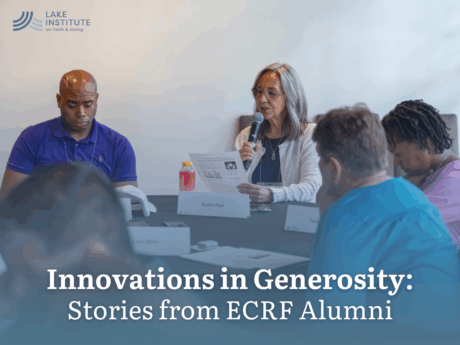
We asked some Executive Certificate in Religious Fundraising (ECRF) Alumni to reflect on this question: “What is an innovative form of generosity you’ve seen in your context in the last year?”
Their responses highlight the creative and meaningful ways generosity is showing up in communities across the country. Here are a few of their stories.
KATE METTS:
ECRF Alumni Kate Metts, Camp Director of Camp Don Lee, shared with us a touching story of generosity through the camp’s first-ever Cans from Campers food drive. Families and campers were invited to bring non-perishable food items at check-in, resulting in more than 2,200 pounds of food donated to Pamlico County Fishes and Loaves Food Pantry.
Reflecting on the experience, Kate shared, “It was new for us and a way for our families to bless the local community, home to our beautiful camp, and serve as an opportunity to discuss generosity and giving in their families and at camp.” This simple yet impactful initiative not only helped stock the shelves of the county’s largest pantry but also encouraged meaningful conversations about generosity among campers and their families.
REV. DR. TIFFANY BENNETT-CORNELOUS:
Alumni Rev. Dr. Tiffany Bennett-Cornelous shared an inspiring example of generosity from her context. A local pastor is offering what is typically a $2,500, 90-minute training session—covering strategies for growth, culture development, spiritual insight, and leadership tools—completely free of charge to small congregations with 99 or fewer members. Many of these churches, often located in rural areas, would otherwise be unable to access this type of training and support.
As Rev. Dr. Bennett-Cornelous reflected, “It’s innovative and generous.”
STEPHANIE ROYAL:
Stephanie Royal shared how her community reimagined generosity in the wake of a crisis. After a tornado struck on May 16, their weekly Community Meal program pivoted from serving meals inside the building to mobilizing volunteers who brought food directly to families impacted by the storm. This transformation turned the meal into a mobile outreach effort, meeting people at their point of need with both nourishment and compassion.
As Stephanie reflected, “It showed generosity not just in what we gave, but in the creative and urgent response to serve those in need.”
RYAN TREADWELL:
ECRF Alumni Ryan Treadwell reflected on how generosity is strengthened through relationships of trust and shared ownership. He has seen that donors are most committed when they trust the character and integrity of the organization’s leaders and are invited into the process as true partners. This approach has built a community of stakeholders deeply invested in advancing the mission.
As Ryan noted, “I know this isn’t a new practice, but it feels like our donors are more committed when they trust the character and integrity of the people leading the organization… Combining that with inviting them into the process, and we have a lot of committed stakeholders invested in seeing our mission continued.”
HODARI WILLIAMS:
Hodari Williams shared a creative example of generosity through a unique community partnership. Seniors came together to create a cookbook, and proceeds from this effort supported a local domestic violence shelter. This collaboration not only raised funds but also strengthened community bonds, showing how generosity can take shape in meaningful and unexpected ways.
JC LYLE:
Alumni JC Lyle lifted up an innovative act of generosity from a North Carolina church that opened its Fellowship Hall to start a respite program for people living with dementia. By transforming their space into a place of care and support, the congregation extended hospitality and compassion in a way that met a critical community need.
